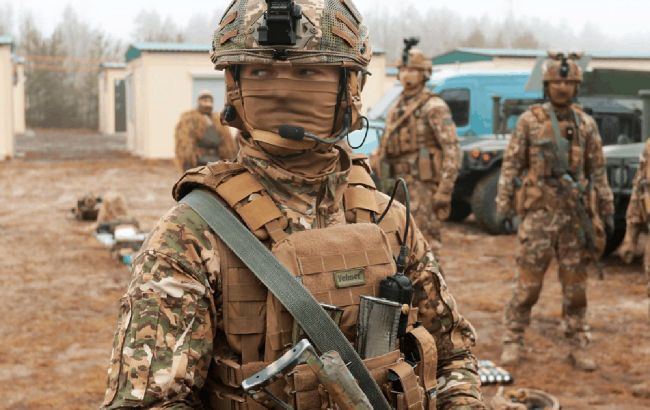Ukraine's counteroffensive and potential war development in 2024: Frontline overview
 Ukraine has different options for war plans in 2024 (cco.mil.in.ua)
Ukraine has different options for war plans in 2024 (cco.mil.in.ua)
The Ukrainian offensive in the South has been almost suspended. The Russians have intensified their offensive in the Donetsk region and want to regain the territories they lost in the summer. Read about the review of the war in 2023 and possible developments in 2024 in the RBC-Ukraine article.
Sources used: Washington Post, statements by commanders and military speakers, as well as conversations with representatives of the Ukrainian military and political authorities on condition of anonymity.
The high expectations that Ukraine and its allies had for the summer and fall campaign were not met. In the main direction of our attack, after three months, the front line shifted to the village of Robotyne. Today, fighting is still taking place in this area, which is ten kilometers from our initial positions.
Now, in their statements, the military and political leadership are making fewer and fewer promises of a quick return of the occupied territories. Society is beginning to realize that the war may drag on for years to come.
It is becoming increasingly difficult for NATO members to compete with Russia in supplying arms and ammunition to the front. The number of Moscow's sympathizers in the EU political arena is growing. Trying to find common ground, European leaders are facing difficulties in allocating aid to Ukraine. Meanwhile, the approaching US presidential race has driven a wedge between the bipartisan unity of the Congress. Financial support for Ukraine has become a hostage to political bargaining between the White House and the Republicans.
In contrast, non-democratic terrorist regimes and dictatorships are showing that they can control the situation more. Crowds of enemy soldiers - some under duress, some for money - continue to pour into the front lines. Despite the disposal of thousands of Russians for a single Ukrainian village, unknown to anyone in Omsk or Kursk, no one in Russia is willing to protest against the war. And it is unlikely that they will, even though Putin is determined to go ahead and send even more people to be slaughtered.
Counteroffensive: unjustified expectations
The triumphant success of the Ukrainian Armed Forces in the Kharkiv and Kherson regions made people believe in the incompetence of the Russian army and the possibility of repeating the same breakthroughs in other areas. According to the agency, the option of an offensive in the South was discussed in government offices as early as 2022. Some politicians and the military believed that it was necessary to break through to Melitopol last fall.
On the other hand, there were warnings that the Ukrainian army did not have enough forces and means to do so and that such an operation would inevitably end in numerous losses and failure. For many, this became a convincing argument to wait with the offensive in the South and limit operations to the Kharkiv and Kherson regions in the meantime. Now, some of our interlocutors in military circles are questioning whether this decision was correct.

While Ukrainian troops were preparing for the offensive, the Russians were preparing a large-scale defense operation (Photo: GettyImages)
The enemy took full advantage of the time available. While NATO countries were trying to find enough weapons and train Ukrainian brigades, the Russians were building a tiered defense and laying minefields.
Since January, the Kremlin has been targeting the occupation of Bakhmut, where, according to Joe Biden, the Russians have lost more than 100,000 troops in five months of fighting. As a result, the Wagner PMC has effectively ceased to exist as a powerful combat unit. Ukrainian politicians and military spokespeople explained that holding Bakhmut was important to grind down and constrain the occupation forces before Ukrainian units launched their offensive. In May, the enemy announced the complete capture of this city. Therefore, whether the months-long battle for Bakhmut increased our chances of success in the offensive or, on the contrary, depleted our resources, as the United States saw it, is an open question.
Around the middle of this spring, RBC-Ukraine's informed sources in military circles claimed that our offensive would begin in May in the South and East and would probably be only partially successful. However, even such moderate forecasts were much more optimistic than reality.
The Ukrainian operation started in June instead of May, although our brigades arrived at the positions several weeks before. The operation did not go according to plan from the very first days. The entire territory that the Ukrainian units with armored vehicles were supposed to pass through was covered with minefields. Their density exceeded all Soviet guidelines - up to five mines per square meter. Many of them were so deeply buried in the ground that aerial reconnaissance could not detect them. The demining equipment available was insufficient.
The occupiers took up positions on the heights. They began to cover our brigades, which had formed into columns to move forward across the open Zaporizhzhia steppes, with fire from anti-tank weapons, artillery, aircraft, and drones. The first to come under attack was the demining equipment moving at the head of the column. Armored vehicles trying to get out of the line of fire risked exploding on the mines surrounding the cleared passage. Mine clearance in the operation area often had to be done manually and at night. However, it often happened that the Russians would remotely scatter new mines in the cleared areas. According to OSINT observers, in the first days of the offensive, Ukrainian brigades lost up to 20 Bradley vehicles and about six Leopard tanks.
Some Western officials and military officials believe that these weeks of waiting in the second half of spring gave the occupiers time to prepare, and therefore it was worth launching the offensive in April. However, in our government circles, they argue that the Russians began preparing their defense in November and that as of the end of April, Ukrainian brigades still did not have all the necessary weapons.
In addition, not everyone in Washington, as the Washington Post has already reported, agreed with the choice of an offensive in three directions - Melitopol, Berdiansk, and Bakhmut. They say it only led to a dispersion of forces.
"Having no numerical superiority in personnel, weapons, or equipment, our offensive in one direction could lead to even greater losses. And end in even smaller territorial gains than we have now. Therefore, we cannot say for sure that the decision to go on three fronts at once was wrong," one of the influential Ukrainian military officials says in an interview with the agency.
Another point that the Washington Post draws attention to is that the United States did not share Ukraine's decision to leave more experienced brigades to defend the East. The newly formed brigades were sent for training and then to the offensive in the South. In the end, this had its logic, the agency's sources explain. If, while the experienced brigades were being trained in winter and spring, the poorly trained units were left to defend the East, the Russians could have approached Kramatorsk before our offensive began.

The United States was hesitant about Ukraine's decision to hold Bakhmut (Photo: GettyImages)
Sometime in the middle of summer, the command decided to focus the offensive only on the Melitopol direction, changing its tactics. Instead of an all-out battle, they chose to attack with small groups of infantry, who were repelling enemy positions step by step. Western officials and analysts believe that the Ukrainian military failed to fully master the combined arms approach and coordinated combat at the brigade level. On the other hand, it is difficult to conduct a full-fledged combined arms battle without effective air cover and weapons that can fire more than 80 kilometers.
The change of tactics ensured the movement forward but still did not help to achieve the objectives. Our units reached the area of Robotyne, Novoprokopivka, and Verbove, the main line of Russian defense. The occupation forces have pulled up reserves there and are regularly trying to counterattack us.
Overestimation of our force and underestimation of the enemy are the key factors that determined the outcome of this year's campaign at the front. After all, history knows no subjunctive mood. Therefore, this experience, for which a great price was paid, should be used to analyze our own mistakes and to assess our enemy more realistically.
What's next
In the fall, the Russian troops launched an offensive, which has not yet come close to its strategic goals. The enemy was unable to align the front line along the Oskil River or reach Lyman or Kupiansk. At the same time, the occupiers became more active on the flanks of Bakhmut, trying to stop our offensive and capture Chasiv Yar. Since October, the Kremlin has focused on taking Avdiivka.
Moscow's initial plan was similar to the operation in Bakhmut. The enemy wanted to surround the city from the north and south, cutting off the main road that supplies the city. Now the Russian occupiers are trying to squeeze into the city from the outskirts through the industrial zone. According to Vitalii Barabash, the head of the Avdiivka City Military Administration, up to 4,000 Russian soldiers were killed and about 400 pieces of equipment were destroyed in the first month of the operation.
Despite the enormous losses, the enemy troops still retain the ability to advance and attack in several directions at once. And it's not just that there are simply more Russians, but also that their army has a very strict system of punishment, like in World War II, such as penal battalions, barrier units, and secret torture chambers where people are thrown for refusing to go on the attack. In addition, many prisoners prefer to join the army rather than survive in the inhumane conditions of Russian prisons.
The agency's intelligence sources say that the Russian command wants to capture as much territory as possible in the Donetsk region before Putin's presidential election in March so that he can report some achievements to his electorate. Now, the Russians have almost taken over the destroyed Maryinka, are fighting for Avdiivka, and may intensify their efforts towards Vuhledar.
The German agency Bild, citing its intelligence sources, recently wrote that the Kremlin wants to capture the entire Donetsk and Luhansk regions by the end of 2024, as well as reach the Oskil River in the Kharkiv region. Further, in 2025 and 2026, Moscow intends to occupy large parts of Zaporizhzhia, Dnipro, and Kharkiv regions, including the city of Kharkiv.
RBC-Ukraine's sources in intelligence and military circles claim that this is indeed one of the scenarios on Putin's table. And this goal is consistent with the current actions of the occupation forces at the front. One of the agency's interlocutors clarified that the Russian army initially had such tasks until the end of 2023, but due to the conditions at the front, plans are being adjusted and the deadlines are being shifted. And despite any public statements made by the Kremlin, they are not ready for any negotiations or peace.

Ukraine may conduct a new offensive in 2024 (Photo: GettyImages)
As for Ukraine's plans for 2024, two options are currently being discussed in government offices. Either conduct an exclusively defensive operation, limiting itself to strikes on enemy territory, increasing its production, and accumulating forces for an offensive in 2025, which is supported by the United States. Or prepare a new offensive operation for 2024, possibly again in the South.
Which strategy will ultimately prevail remains to be seen. But whatever the choice, it will still require new asymmetric solutions, approaches, and, of course, continued Western support. Otherwise, at best, we will only be able to gnaw away at a dozen kilometers a year.
Now, any forecasting horizon ends in November 2024, when the United States presidential election will be held. What to expect if Biden wins is pretty clear. However, Trump's arrival in the White House is more like roulette. His position will largely be determined by the military situation in the spring, summer, and fall. If the frontline stagnates or we continue to lose territory, this could push Trump to advocate for an end to the war - not on Ukraine's terms.

